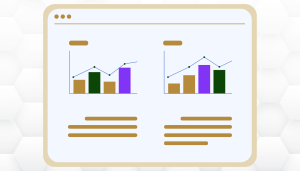
Share
Another growth e-commerce article? Come o-n-n-n. Can you write about anything else, Noelani? Employee updates? Ad Purp culture? Dogs? Best pho and banh mi spots in Southern California? How to deal with your upstairs neighbor’s mind-numbingly loud death-metal-fueled workout sesh? Anything?
Listen, me, (that felt a little too Shutter Island) I hear you and I want you to know all those ideas are golden. I’m on it. Here for you. With you. But with us being only eight days into the second quarter of the year, it’s near impossible to not want to wax optimistic about growth. As 2021 progresses, that *deep sigh* “new year, new me” mentality follows closely behind and with it, the desire to want to do better for ourselves and our businesses.
Before this completely devolves into a total sugar-sweet motivational speech, let me get this in. Like we talked about in the quarter one trends post, e-commerce isn’t going anywhere anytime soon. So, I’m here to revel in that glory just a little more with a healthy serving of tips for driving growth in 2021. Who’s with me?
1. Omnichannel selling strategy
As shoppers continue to adjust to the pandemic-sparked reality that we live in, they’ve come to raise their expectations of the shopping experience. Whether they want the two-day shipping that Amazon has championed, flexible checkout options, or easier website navigation, it’s clear that they’re seeking convenience. They want to shop wherever they’re already spending time, and who can blame them?
That’s where omnichannel retail comes in (cue “The More You Know” rainbow effect). Omnichannel, despite what the prefix suggests, isn’t about being everywhere. It’s just about being where your customers are. It’s about giving your customers an integrated and frictionless experience where they can interact with your brand across channels they frequent. Think of it as a modern approach to commerce that’s more than coalescing brick-and-mortar with their branded websites. It’s removing boundaries and connecting dots between both of those channels and others, including social media and online marketplaces.
The seamlessness of this strategy explains why IDC Retail Insights reports a 15-35% increase in average transaction size, a 5-10% increase in loyal customer’s profitability, and a 30% higher lifetime value for those who use omnichannel strategies. I’ve gotta say, I see why. Not only does this strategy bring customers the ability to purchase wherever they are, but it demonstrates awareness of their stage in the customer lifecycle. It uses information about one sales channel to encourage customers to participate in others. When done skillfully, customers can fluidly transition from one channel to another while immersing themselves deeper into the brand experience.
2. Prioritized mobile shopping
Speaking of all the above, the easiest enabler of seamless omnichannel shopping is, by far and away, mobile e-commerce. That mobile e-commerce sales have increased 39.1% from its 52.4% market share of total e-commerce sales to the current 72.9% market share is just proof in the pudding. So, what does this tell us? That we should capitalize on that 72.9% by providing a rich and uninterrupted mobile experience.
For a little behind the why I had to pull up a sobering stat. According to CJ Affiliate’s 2021 Outlook report, 53% of consumers will abandon a site that takes longer than three seconds to load on mobile. Three seconds. That’s not even enough time for anyone to ponder what adrenaline-fueling song they want to play next off their work-from-home playlist. But it’s more than page loading speeds that shoppers have high expectations for. It’s account creation, checkout ease, search functionality, and more.
It might be an intimidating fact, but don’t worry. You can still win the mobile game. How? Well, I’m just spitballing here, but I have a few ideas to fuel your brainstorms:
- Evaluate and optimize your website through automated mobile acceleration solutions to ensure lightning-quick loading speeds (start with the Google Mobile-Friendly Test)
- Eliminate unnecessary words from your website to better serve customers’ specific searches
- Streamline your checkout process with payment methods like Apple Pay and Shop Pay
- Allow for easy account creation through existing Facebook, Twitter, and Instagram accounts
- Allow your customers to shop your product through your Instagram, Facebook, and Pinterest accounts for speed and maximum convenience
3. Loyalty Programs
Something you’ll notice about these growth drivers is that they’re all customer-centered, and this one is no different. Meeting the new expectations of shoppers to drive sales is only a piece of the puzzle. Retaining those shoppers is a different 1000-piece of the Rock’s face, or whatever you fancy. And what value do repeat customers bring? Why it’s elementary, my dear Watson. A higher lifetime value. You might now be wondering, what’s a good way to promote customer retention? I got you. Let’s talk loyalty.
Loyalty continues to bring positive outcomes for brands and the impact it has on retention and spend remains powerful. So much so that 72% of customers say that they’re more likely to recommend brands with good loyalty programs. CJ Affiliate backs up its value with a report that customers are 47% more likely to make a second purchase if easily redeemable rewards are available. Need I say more?
It may be easier said than implemented, but it doesn’t have to be complicated. Loyalty programs can be as simple as offering first-time or repeat customers discounts and rebates, rewards, free products, coupons, and access to unreleased products. Who doesn’t love feeling special? I’ll wait.
————
I’m not Tony Robbins and you didn’t pay at least a quarter of your April rent to hear me talk about optimizing your life, but I hope this leaves you with some nuggets to think about. If it elicits even one-sixteenth of the inspiration that one of those pep talks would, I’m a happy camper. Though, if we’re talking outdoors, I’m more drawn to the water being from Hawai’i and all. Anyway, you get it.





